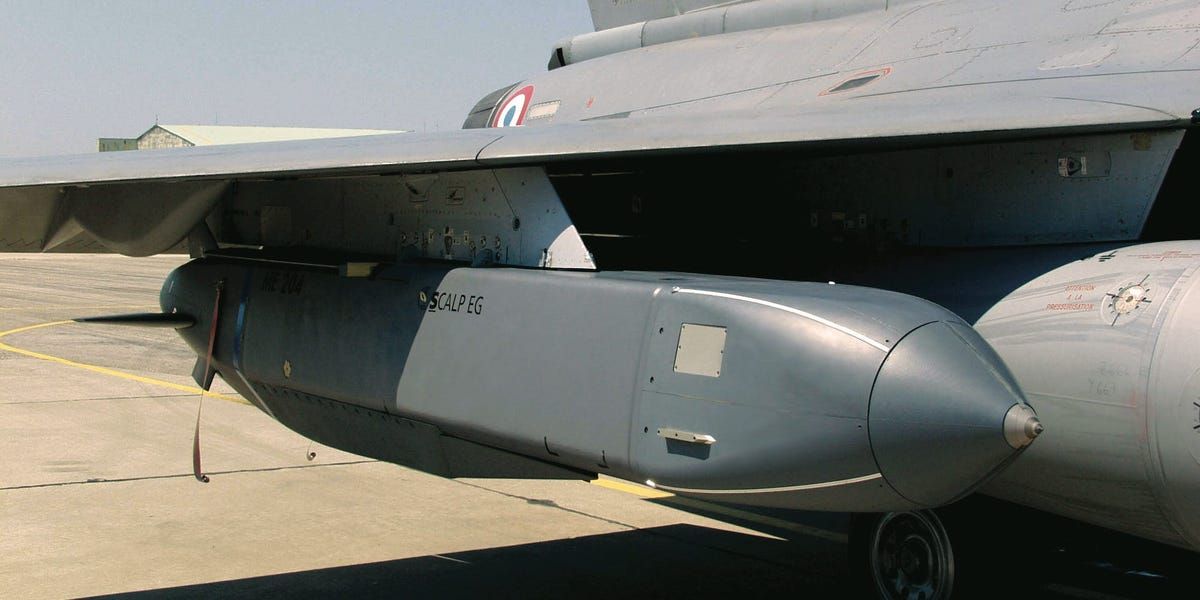Ukraine's Storm Shadow Missile Is Effective, but Russia Is Adapting
The Storm Shadow cruise missile is the latest highly touted weapon employed by Ukraine.
The missile has been effective, striking important targets deep inside Russian-held territory.
But Russian adaptations over the past year have limited Storm Shadow's impact, one expert said.
Get the inside scoop on today’s biggest stories in business, from Wall Street to Silicon Valley — delivered daily. Loading Something is loading. Thanks for signing up! Access your favorite topics in a personalized feed while you're on the go. download the app Email address By clicking ‘Sign up’, you agree to receive marketing emails from Insider as well as other partner offers and accept our Terms of Service and Privacy Policy
First it was drones and then HIMARS. With depressing regularity, a new wonder weapon has been touted as a game-changer for Ukraine, only for its luster to dim as Russia adapts to it.
The latest example is the Storm Shadow, an air-launched cruise missile developed by the UK and France that Ukraine has used to spectacular effect, notably in a strike in June that damaged the vital Chonhar bridge between the Crimean peninsula and southern Ukraine.
Some observers believe Storm Shadow will be crucial to Ukraine's counteroffensive. The missile's 155-mile range allows Ukrainian jets to launch it while staying out of range of Russian air defenses. In addition to a 1,000-pound warhead and stealth features, Storm Shadow has multiple guidance systems, including GPS, inertial guidance, and terrain-following radar, that enable it to avoid detection by flying just a few hundred feet above the ground.
"They're effective weapons," Michael Kofman, an expert on the Russian military at the Carnegie Endowment for International Peace, said on a July 14 episode of the Geopolitics Decanted podcast, recorded while visiting Ukraine. "They're difficult to intercept, and it gives Ukraine, to put it crudely, a much longer stick."
A British Royal Air Force Tornado GR4 loaded with four Storm Shadow missiles during a test over the Atlantic Ocean. Cpl Mark Parkinson/UK Ministry of Defence
While HIMARS initially proved devastating in Ukrainian attacks on supply depots and command posts, the Russian military was able to adapt — though at some cost to efficiency — through use of electronic warfare and by moving logistical sites and headquarters out of range of HIMARS' guided rockets.
There have been reports of successful Storm Shadow strikes in the weeks since the attack on the Chonhar bridge, including the killing of a senior Russian commander and an attack on a Russian vehicle repair depot in Crimea.
But since Ukraine began using the missiles in mid-May, "we've not seen tremendous impact on the Russian force," Kofman said, "and part the reason for that is the adaptations in the Russian military that were caused by the introduction of HIMARS last June."
Ukraine's long-range weapons will continue to have an impact. With an extensive front like that in Ukraine, it's impossible for the Russian military "to not have ammo stored anywhere, or to not have vulnerabilities in command-and-control, or to not have to use bridges," Kofman said. "But you're not seeing nearly the amount of critical infrastructure strikes or strikes against the logistics command-and-control network that you saw when HIMARS was first introduced last summer."
Ukraine also faces limitations in its use of Storm Shadows. Kyiv has likely only received a few hundred missiles, and the aircraft launching them are vulnerable in the highly contested airspace over Ukraine. That raises questions about whether Ukraine's military can bring enough Storm Shadows to bear against targets that are hard to find or hard to knock out.
Ukrainian troops fire HIMARS rockets toward Bakhmut in May. Serhii Mykhalchuk/Global Images Ukraine via Getty Images
In the fighting around Kherson during Ukraine's counteroffensive last fall, Russia sustained and eventually withdrawn its forces using one bridge and a ferry system. "You'd be surprised how many forces can be sustained with a fairly narrow pipeline when it comes to ground lines of communication," Kofman said.
This has implications for the next wonder weapon on Ukraine's wish list: the US-made MGM-140 Army Tactical Missile System, known as ATACMS, a ground-launched weapon with a range of 190 miles, longer than Storm Shadow's 155-mile range and HIMARS' 50-mile reach.
The US has so far refused to provide ATACMS to Ukraine out of concern about its use against targets inside Russia — though the Biden administration is now reconsidering that policy — but some Western and Ukrainian experts believe a long-range weapon like ATACMS could reshape the conflict.
If history is a guide, however, ATACMS would have a certain degree of success before the shock fades and Russia adapts. Storm Shadow missiles, while effective, have a "very similar capability with a very similar payload used very much against the targets that ATACMS would have been used against," Kofman said on the podcast.
While new long-range weapons could still hurt the Russian war machine and force the Russian military to alter its operations, the question is whether their impact will be limited to the tactical level or if it will be profound enough to tilt the conflict in Ukraine's favor.
Michael Peck is a defense writer whose work has appeared in Forbes, Defense News, Foreign Policy magazine, and other publications. He holds a master's in political science. Follow him on Twitter and LinkedIn.
Source: Business Insider


